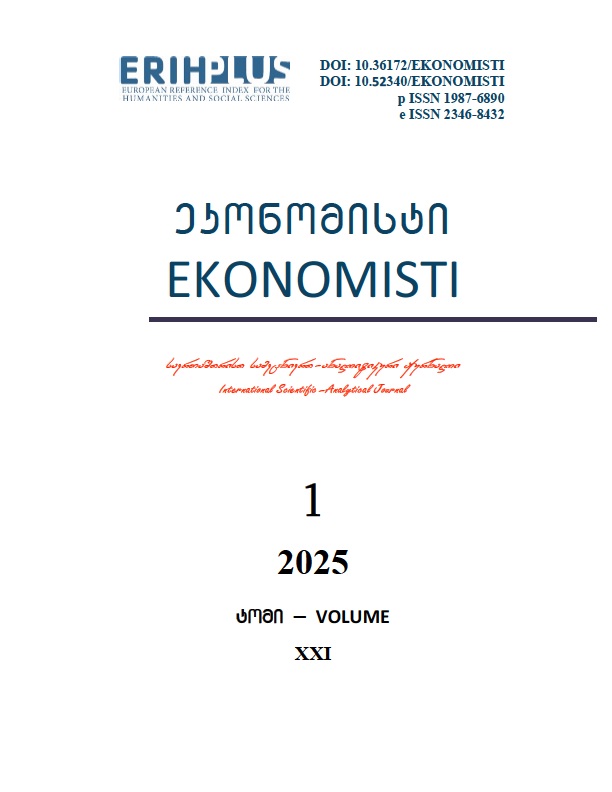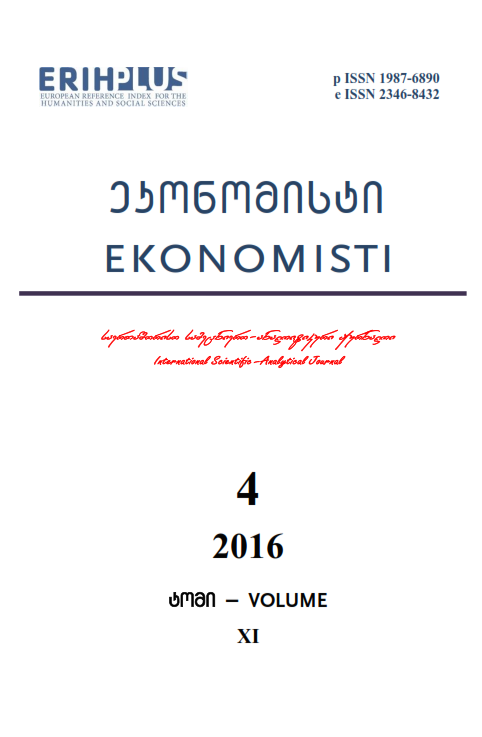
EKONOMISTI
The international scientific and analytical, reviewed, printing and electronic journal of Paata Gugushvili Institute of Economics of Ivane Javakhishvili Tbilisi State University
The international scientific and analytical, reviewed, printing and electronic journal of Paata Gugushvili Institute of Economics of Ivane Javakhishvili Tbilisi State University

Journal number 4 ∘ Ramaz Abesadze ∘ Shota Veshapidze ∘
DEVELOPMENT OF ECONOMIC SCIENCE IN GEORGIA[1]
Summary In the work are reviewed a spects of development of Economic Sciences in Georgia from its beginning up today. The attention is paid to the organizations and scientists who contributed significantly to the development of Economic Science in Georgia. Keywords:Kolkheti Kingdom, doctrine of mercantilism, kalmasoba, physiocratic ideas, european economic values Introduction Economic development in Georgia has deep century roots. In the 6-7th centuries BC agriculture and workmanship were developed and minted"kolkhuri tetri"in the Colchis Kingdom. Further the high level of development was reached by Iberia (The Kartli kingdom) which had commercial relations as with the neighboring as well as with distant countries. Interesting considerations from different spheres of economic activity are given in the Georgian historical, literary, philosophical and theological sources of that time. Economic views took scientific image only in 20s of XX century. Economic views of feudal Georgia TJournal number 4 ∘ Vakhtang Burduli ∘
PROBLEMS OF IMPROVEMENT OF THE SECTORAL STRUCTURE OF GEORGIAS ECONOMY
Summary The article deals with the problems connected with the improvement of the sectoral structure of the Georgian economy on the basis of its diversification and increase in the volume of exports, as well as the expansion of the scale of import-substituting production. In this connection, the understanding of the structural effect (primarily its structural and sectoral aspects) and ways of its evaluation, including the assessment of the level of self-sufficiency of the economy, is being studied. The level of self-sufficiency of the economy in the context of enlarged groups of industry has been studied and on this basis directions for improving the sectoral structure of the Georgian economy have been suggested (by outstripping growth of priority sectors). Key words: sectoral structure of the economy, structural effect, level of self-sufficiency of the economy, formation of a progressive sectoral structure Introduction Over 25 years have passed since the beginning of post-communisJournal number 4 ∘ George Berulava ∘ Irma Dikhaminjia ∘ Natia Ghvinjilia ∘
The Microeconomic Effects of Migration on Labor Market: Evidence from Georgia
Summary Georgia has experienced large-scale emigration since the period following the breakup of the former Soviet Union in 1991 and obtaining independence. There were several driving forces behind migration processes in Georgia: political and ethnic conflicts (and as sequence a substantial number of refugees) as well as economic motives due to deterioration of national economy (Gerber & Torosyan, 2013). Because of these processes, thousands of people emigrated from Georgia in a search of high-wage employment opportunities. According to National Statistics Office of Georgia, approximately 867.6 thousand of persons out-migrated from Georgia during the period of 1991-2005. Along with increase in international migration, remittance inflows into Georgian economy have boosted dramatically. In 2015, net remittances from abroad accounted for almost 1.5 billion US$ or 10.4% of GDP (OECD/CRRC-Georgia, 2017). Though remittances from international migration, in general, have posiJournal number 4 ∘ Khatuna Barbakadze ∘
About the optimization of company structure
Summary Actuality. The optimal structure of the capital represents ratio between own and debt funds, during which effective interconnection is ensured between the coefficients of own capital profitability and debt. [Бланк И. А. Управление формированием капитала. Киев: Ника-Центр, 2000]. Optimization of capital structure is the most difficult procedure in process of corporate finance management because it represents the compromise between the usage of capital debt and reliability and stability of own financial resources. Insolvency is a difficult economic-legal phenomenon, which, on the one hand is an ineffective product of operational activity and on the other hand it represents stimulus for effective working in the companies. To solve the problems of insolvency in companies, it is necessary to unify the efforts of modern scientific knowledge, economic experience, business community and financial institutions. Functioning of tJournal number 4 ∘ Olesya Stroeva ∘ Olga Komarevtseva ∘
DESTRUCTIVE DEVELOPMENT OF THE NATIONAL ECONOMY IN THE EPOCH OF DIGITALIZATION
Summary This article examines the key features of the process of the Russian economy during the period 1990 - 2017. The destructive development of external conditions and the absence of a smooth transition from the implementation of one economic concept to another do not allow to form effective prerequisites for the digital paradigm of Russian society. Based on this thesis, the authors attempt to identify negative trends throughout the development of the market economy, which prevent a breakthrough in the digital transformation of the Russian system of economic relations. The purpose of the scientific article is to identify the stages of destructive development of the national economy and to identify the characteristic process models of development in conditions of lability, cathartic and deformation. The hypothesis of scientific research is reduced to the idea of the impossibility of the transition of the Russian economy to a digital paradigm of development. This phenomenon is associJournal number 4 ∘ Giorgi Gaganidze ∘
Creation of the Efficiency Export Strategies in Modern Period
Expanded Summary Priorities for the creation of the export strategies in Georgia: products vs. markets Efficient export strategies always reviewed as one of the main indicators of the successful economic policy provided by Government. Successful export strategies improve many fundamental economic indices, such as balance of payments, employment, budget revenues. Thus due to the importance of the topic many authors researched different aspects. In the new reality of the globalization many things are changing. Export markets become the source for the survival for the firms, thus export opportunities aren’t considered as the ways of growth, now it’s the way to survive. Different models for the export growth have been presented, as the well-known “Uppsala model”, also there are other different ideas re-firm growth. International Donor organization also were quite interested to introduce export growth models which lead to the poverty reduction or intensified eJournal number 4 ∘ Tea Lazarashvili ∘
The characteristics of the formation of national innovative systems at the modern stage
Summary The article discusses the formation of the national innovative systems and factors influencing them. Are highlighted those signs of general national systems characteristic to them as interactive blocks. In particular creative block, technology transfer block, production block and staff training block. Analysis of the national innovation systems in the world has shown that 5 basic types of national innovation systems are explicit. These are: euroatlantic, easterasian, three-dimensional spiral and four-dimensional spiral model. Each system is characterized by their peculiarities and accordingly the countries where these systems are used. Keywords: National Innovation System, Atlantic, Oriental, Triple Spiral. Introduction At the beginning of the XXI century the change of the main factor of economic development started, which laid the basis for the formation of a new type of economy, where the knowledge factor plays a decisive role, while knowleJournal number 4 ∘ Tengiz Verulava ∘
Health System Reforms in the US: Individualism and Universalism
Expanded Symmary On April 1, 2014 came into effect one of the key elements of health care reform, initiated by Barack Obama - compulsory health insurance for individuals. From now on, all uninsured Americans must purchase a medical insurance policy under the threat of fines from the state. It has been over 4 years since, both in the United States passed a law on the reform of the health insurance. Since the reform continually stalled, encountering opposition resistance, technical difficulties, trials and lack of understanding on the part of a significant part of American society. The main objective of the reform of Barack Obama was the expansion of coverage of the population with health insurance, as well as improving access to health services. The law on the protection of patients and access to health care (Patient Protection and Affordable Care Act - ACA) 3 was adopted in March 2010, after a long debate in Congress due to the resistance of the Republican opposition. He is known bJournal number 4 ∘ Giorgi Miqeladze ∘
Investments accelerator and Tobins Model (Case of Georgia)
Summary The article discusses the importance of the total capital in the process of total investment studies, calculation method of Georgia’s total capital and the opportunity of practical realization of above mentioned method. Research uses quarterly empirical data from 2003-2016 years. The article empirically examines Modified case of L.M. Koyck’s investments accelerator model and Tobin’s investments model on example of Georgia. Practical models consider country’s economic specification and important events (results of the war in august, 2008 year). Empirical studies validate interrelation of GDP’s and total investments’ current and lagged values with total capital. Also, research estimates quarterly values of Georgia’s total capital from 2003 year to 2016 year and depreciation rate, which is equal to 5.7%. Key words: total investments; Georgia’s total capital; L. M.Koyck’s investments accelerator model; Tobin’s investmeJournal number 4 ∘ Luka Lazviashvili ∘
The Characteristics of Inclusive Economic Development of Georgia
Expanded summary International organizations like United Nations Organization, International Monetary Fund, The World Bank and The Organisation for Economic Co-operation and Development frequently hold events and conferences to discuss an economic problems of the world and to provide countries with helpful package of instructions. Inclusive Growth (IG) became the most accentuated aim of the world economies since the concept of it was firstly widely considered in report published by The World Bank's Commission on Growth and Development (CGD) in 2008, entitled The Growth Report: Strategies for Sustained Growth and Inclusive Development. According to OECD Inclusive Economic Growth creates opportunities for all segments of society and distributes gained utility fairly to the whole society. According to The World Bank to eliminate poverty totally and quickly there is necessity of inclusive growth what gives to the whole society a chance of being involved in the process of economic gJournal number 4 ∘ Nino Papachashvili ∘ Paskal Zhelev ∘ Lela Jamagidze ∘
ECONOMIC RELATIONS BETWEEN GEORGIA AND BULGARIA: CURRENT STATE AND PROSPECTS
Summary Currently progressive steps are being taken to develop Georgia-EU economic cooperation. A new Association Agenda for 2017-2020 has officially entered into force [Association Agenda, 2017], which enables Georgia to ensure the highest possible degree of approximation with EU standards and norms by 2020. The EU confirms its willingness to continue its eastern enlargement, while Georgia has an ambition to further expand its regional economic cooperation and ultimately become a member [Grigalashvili, p. 2, 2017]. At the Eastern Partnership Summit 2017, it was clearly stressed that the support by the EU for bilateral relations among the partners is very important, so that partner countries get real gains from the DCFTA [Eastern Partnership - 20 Deliverables for 2020, p. 20, 2017]. Considering the above political orientation, the study of the opportunities and the foundations of economic cooperation with EU countries is paramount because the success and achievements in institut
